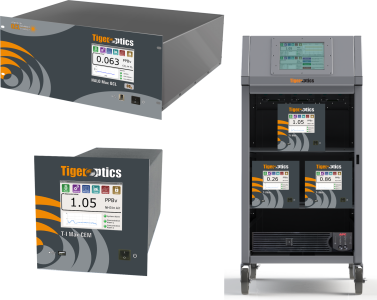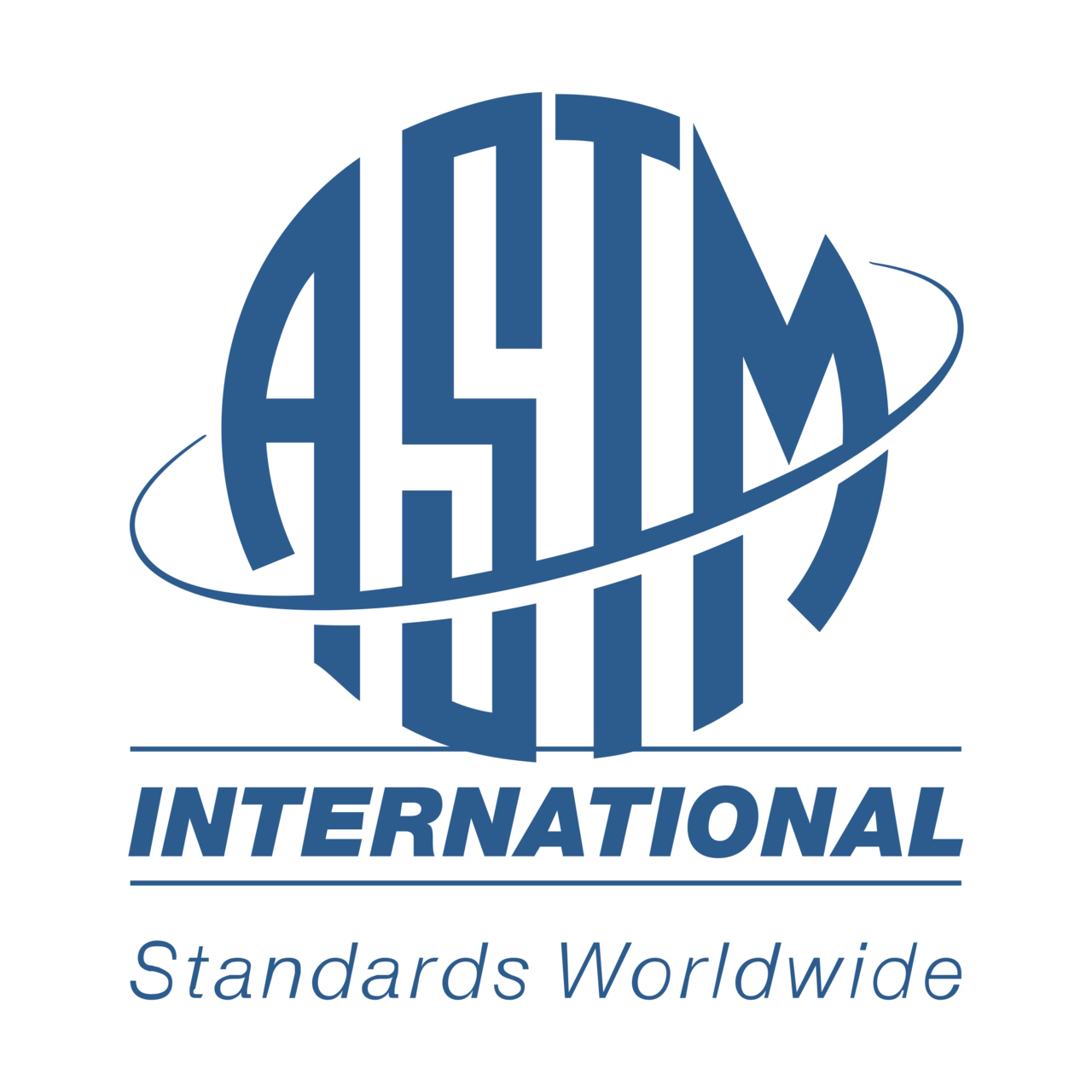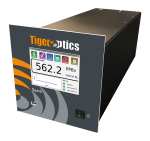CRDS Gas Analyzers
Cavity Ring-Down Spectroscopy for Trace and High Purity Gas Analysis
CRDS Gas Analyzers for Trace and High Purity Gas Analysis
Our TIGER OPTICS™ Cavity Ring-Down Spectroscopy (CRDS) gas analyzers have a long history in industrial gas, medical gas, and chemical processing enabling detection of moisture and other rogue impurities in process gas streams, including inert, reactive, corrosive, bulk and specialty gases.
Cavity Ring-Down Spectroscopy (CRDS) technology is a highly sensitive and precise analytical technique used for the detection and measurement of trace gases and isotopes in a sample. It is a non-destructive technique that provides quantitative measurements of molecular absorption spectra.
Our Cavity Ring-Down Spectroscopy (CRDS) technology works by measuring the rate at which light is absorbed by a gas sample contained in a highly reflective cavity. A laser pulse is introduced into the cavity, and the light bounces back and forth between two highly reflective mirrors at the ends of the cavity. As the light bounces back and forth, it is absorbed by the gas sample in the cavity, causing a gradual decrease in the intensity of the light. The time it takes for the light to decay or “ring down” to a predetermined threshold level is measured, and this decay time provides information on the concentration of the gas species in the sample.
Curious about the HALO Max QCL?
Watch this video and see how fast our CRDS technology really is.


HIGH PURITY RESOURCES
SALES | TRAINING INQUIRIES
AMERICAS: info.americas@process-insights.com
EMEAI (includes India): info.emeai@process-insights.com
APAC: info.apac@process-insights.com
CHINA: info.cn@process-insights.com
FUEL CELL HYDROGEN ANALYSIS BULLETIN
Find out how the combined portfolio of Process Insights’ powerful analytic instruments for analysis of fuel-cell-grade hydrogen offers:
- Combination of three powerful analytical technologies: Cavity Ring-Down Spectroscopy (CRDS), Mass Spectrometry (MS) and Gas Chromatography (GC)
- Analysis of all critical contaminants listed in hydrogen purity standards ISO 14687 and SAE J2719
- Ideal detection limits from part-per-million (ppm) down to sub-part-per-billion (ppb) in line with requirements outlined in ISO 21087
CQC Monitoring Solutions
- Offers multiple technology choices to meet all customer needs
- Expert team who understands and supports all UHP and Semi applications IQC/OQC/CQC
- Delivers both pre- and post-purifier trace impurity measurements
- 1-year warranty on all analyzers and cabinets
- 2-years of on-site service and spare parts
Two CQC Monitoring Solutions Available
- Cavity Ring Down Spectroscopy CQC has great performance at highly competitive price
- Atmospheric Pressure Ion Mobility Spectrometry has the lowest detection limits available and covers the entire application with one analyzer
Simultaneously Monitor HF, HCl, and NH3 in Real-Time
T-I MAX X3 AMC MONITORING SOLUTION
Next-Generation Trace Gas Analyzers for Detection & Continuous Monitoring of Airborne Molecular Contaminants in Semiconductor Cleanrooms, FOUP Cleaning Tools, Reticle Nests and Sub Fab Environments. You can spend a long time “looking” for Airborne Molecular Contaminants (AMCs) when the catastrophic product performance or yield loss is discovered at your device final test stage; or you can deploy our T-I Max™ series analyzers to locate and to monitor these invisible defect generators, commonly found lurking in and around equipment, personnel, wafer carriers and cleanroom bays.
solutions flyers

NATIONAL INSTITUTE OF STANDARDS AND TECHNOLOGY (NIST)
The National Institute of Standards and Technology (NIST) used our TIGER OPTICS HCl analyzer to develop its HCl standards. Our TIGER OPTICS HCl analyzers were used by the National Institute of Standards and Technology (NIST) to develop its HCl standards through a process known as gravimetric preparation. In this process, a known amount of pure HCl gas is diluted with a carrier gas, typically nitrogen, to create a sample with a known concentration of HCl. The sample is then passed through a TIGER OPTICS HCl analyzer to verify the concentration.
By using the HCl analyzer, NIST was able to precisely measure the concentration of HCl in the gas mixture, which allowed them to accurately prepare the HCl standards. The high sensitivity and accuracy of the TIGER OPTICS HCl analyzer ensured that the standards were of the highest quality, which is essential for accurate measurements in a wide range of applications.
In another study, NIST researchers evaluated the performance of a CRDS instrument for measuring methane (CH4) in natural gas samples. They found that the instrument was highly accurate and precise, with a measurement uncertainty of less than 0.1% over a range of concentrations.

DESIGNATION: D7941/D7941M − 23
Standard Test Method for Hydrogen Purity Analysis Using a Continuous Wave Cavity Ring-Down Spectroscopy Analyzer
SCOPE
1.1 This test method describes contaminant determination in fuel cell grade hydrogen as specified in relevant ASTM and ISO standards using cavity ring-down spectroscopy (CRDS). This standard test method is for the measurement of one or multiple contaminants including, but not limited to, water (H2O), oxygen (O2), methane (CH4), carbon dioxide (CO2), carbon monoxide (CO), ammonia (NH3), and formaldehyde (H2CO), henceforth referred to as “analyte.”
1.2 This test method applies to CRDS analyzers with one or multiple sensor modules (see 6.2 for definition). This test method describes sampling apparatus design, operating procedures, and quality control procedures required to obtain the stated levels of precision and accuracy.
SCOPE
1.1 This test method describes contaminant determination in fuel cell grade hydrogen as specified in relevant ASTM and ISO standards using cavity ring-down spectroscopy (CRDS). This standard test method is for the measurement of one or multiple contaminants including, but not limited to, water (H2O), oxygen (O2), methane (CH4), carbon dioxide (CO2), carbon monoxide (CO), ammonia (NH3), and formaldehyde (H2CO), henceforth referred to as “analyte.”
1.2 This test method applies to CRDS analyzers with one or multiple sensor modules (see 6.2 for definition). This test method describes sampling apparatus design, operating procedures, and quality control procedures required to obtain the stated levels of precision and accuracy.
1.3 The values stated in either SI units or inch-pound units are to be regarded separately as standard. The values stated in each system are not necessarily exact equivalents; therefore, to ensure conformance with the standard, each system shall be used independently of the other, and values from the two systems shall not be combined.
1.4 This standard does not purport to address all of the safety concerns, if any, associated with its use. It is the responsibility of the user of this standard to establish appropriate safety, health, and environmental practices and determine the applicability of regulatory limitations prior to use.
1.5 This international standard was developed in accordance with internationally recognized principles on standardization established in the Decision on Principles for the Development of International Standards, Guides and Recommendations issued by the World Trade Organization Technical Barriers to Trade (TBT) Committee.
HOW WE ARE DIFFERENT FROM OUR COMPETITORS
- Measurement Principle: Our gas analyzers use Cavity Ring-Down Spectroscopy (CRDS), which measures the decay time of light resonating inside an optical cavity filled with the gas that is being analyzed. Unlike techniques used by most of our competitors, this time-based principle allows for absolute accuracy and insensitivity to various noise sources.
- Detection Limit: The absorption enhancement of the optical cavity gives our CRDS systems a lower detection limit than many of our competitor’s gas analyzers, making them better suited for measuring trace and ultra-trace levels gases.
- Calibration: Our CRDS gas analyzers are factory-calibrated against NIST-traceable standards and are free from long-term drift, removing requirements for regular field calibrations, while our competitor’s gas analyzers require recalibration at regular intervals to correct for drift.
- Specificity: Using narrow-linewidth lasers as light sources, our CRDS analyzers are highly specific to the target analyte and are free from most common interferences. Our competitor’s gas analyzers often require sample conditioning to remove interfering species or additional calibration steps to cancel out their effect on the concentration measurement.
SPECIFICATIONS & DETECTION CAPABILITIES TABLE
Not sure what you need? Unfamiliar with our CRDS gas analyzer portfolio?
Looking for a summary of our Cavity Ring-Down Spectroscopy (CRDS) Analyzer Specifications and Detection Capabilities?
SPARK INSTALLATION IS FAST!
Watch and see how quickly the installation process is with our Spark.
Our CRDS Gas Analyzers for High Purity Applications
SOFTWARE FOR OUR CRDS ANALYZERS

SPEED SOFTWARE
Great News! We now offer a new CRDS analyzer performance upgrade. Implementing our new intelligent dynamic data processing, the Speed+™ Analyzer Performance Upgrade Software adjusts your analyzer’s response automatically and in real-time to deliver the best performance. Find out more.
SERANI MAX INTERFACE SOFTWARE
Serani™ Max Analyzer Interface Software allows you to have remote access from your desktop computer or laptop for our latest generation of CRDS analyzers. The Windows-based software package allows full control of the system conveniently from your desk. Get the details!
SERANI SOFTWARE
Our Serani™ Analyzer Interface Software offers users a way to access most of our legacy platform analyzers remotely from any computer or laptop. The Windows-based software package communicates with the analyzer through RS-232 or Ethernet and allows full control of the system and data collection.





















































